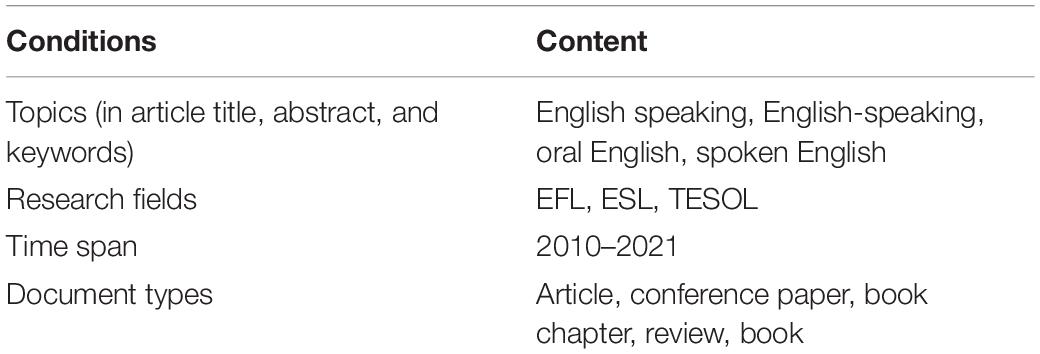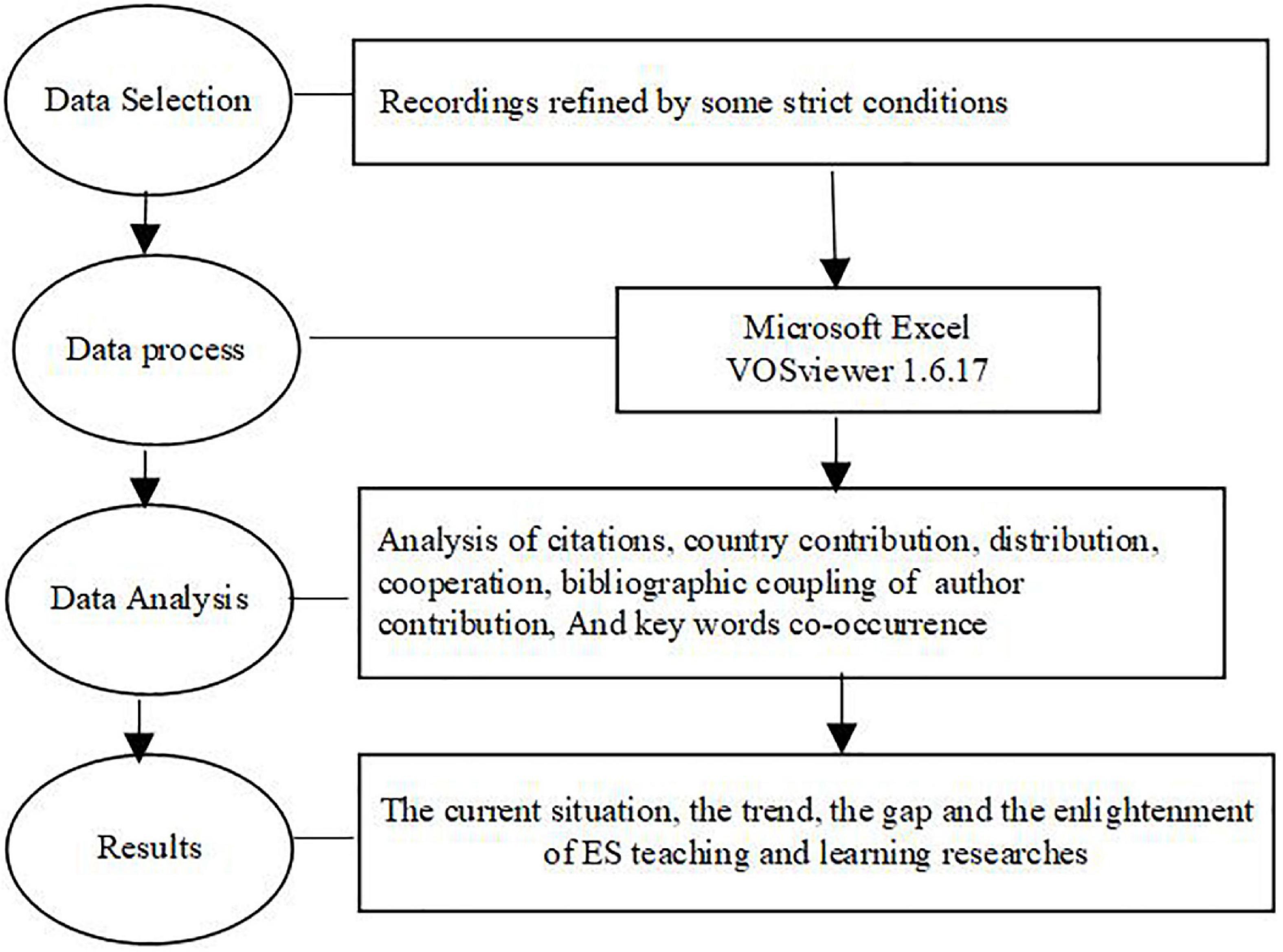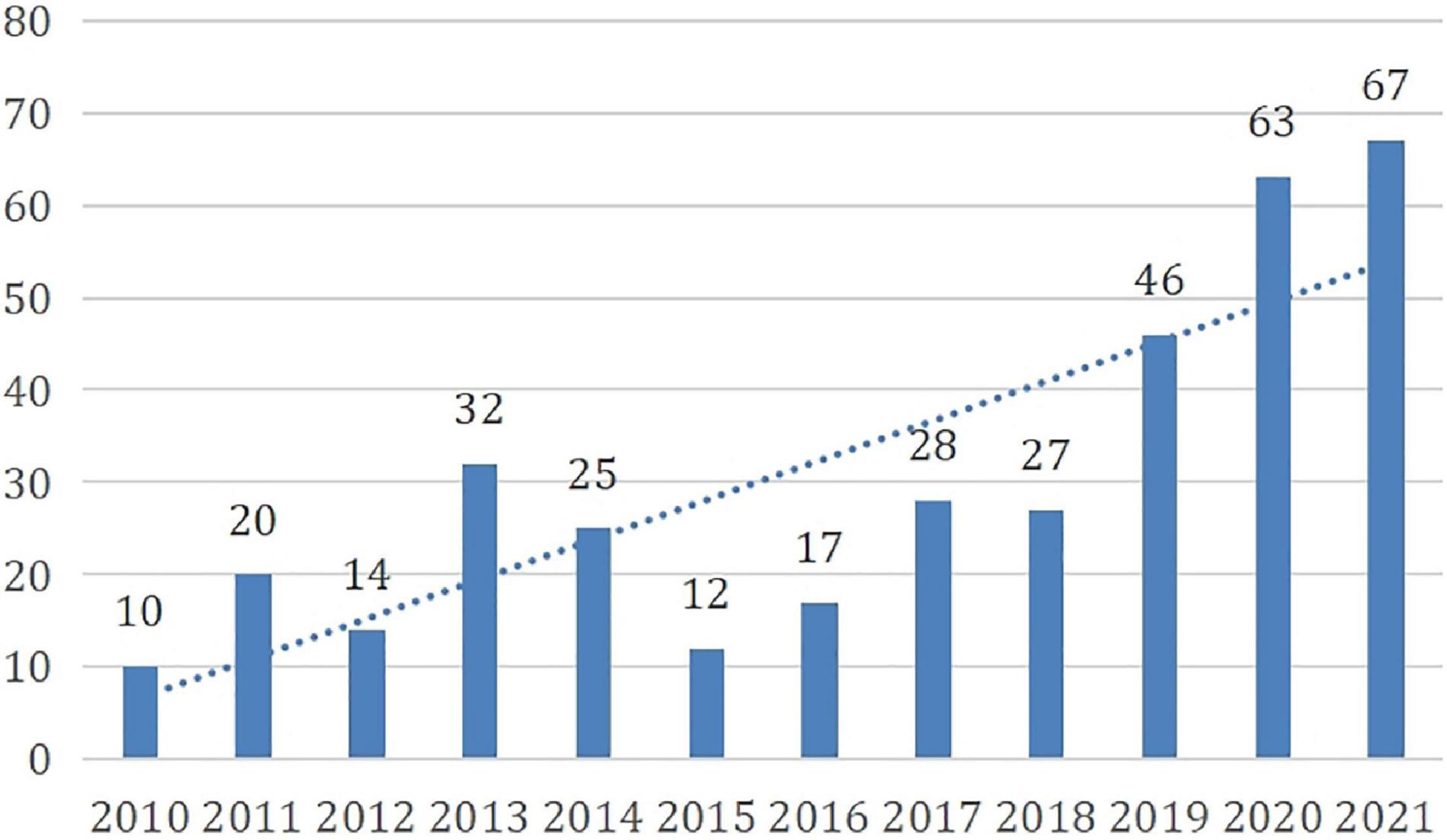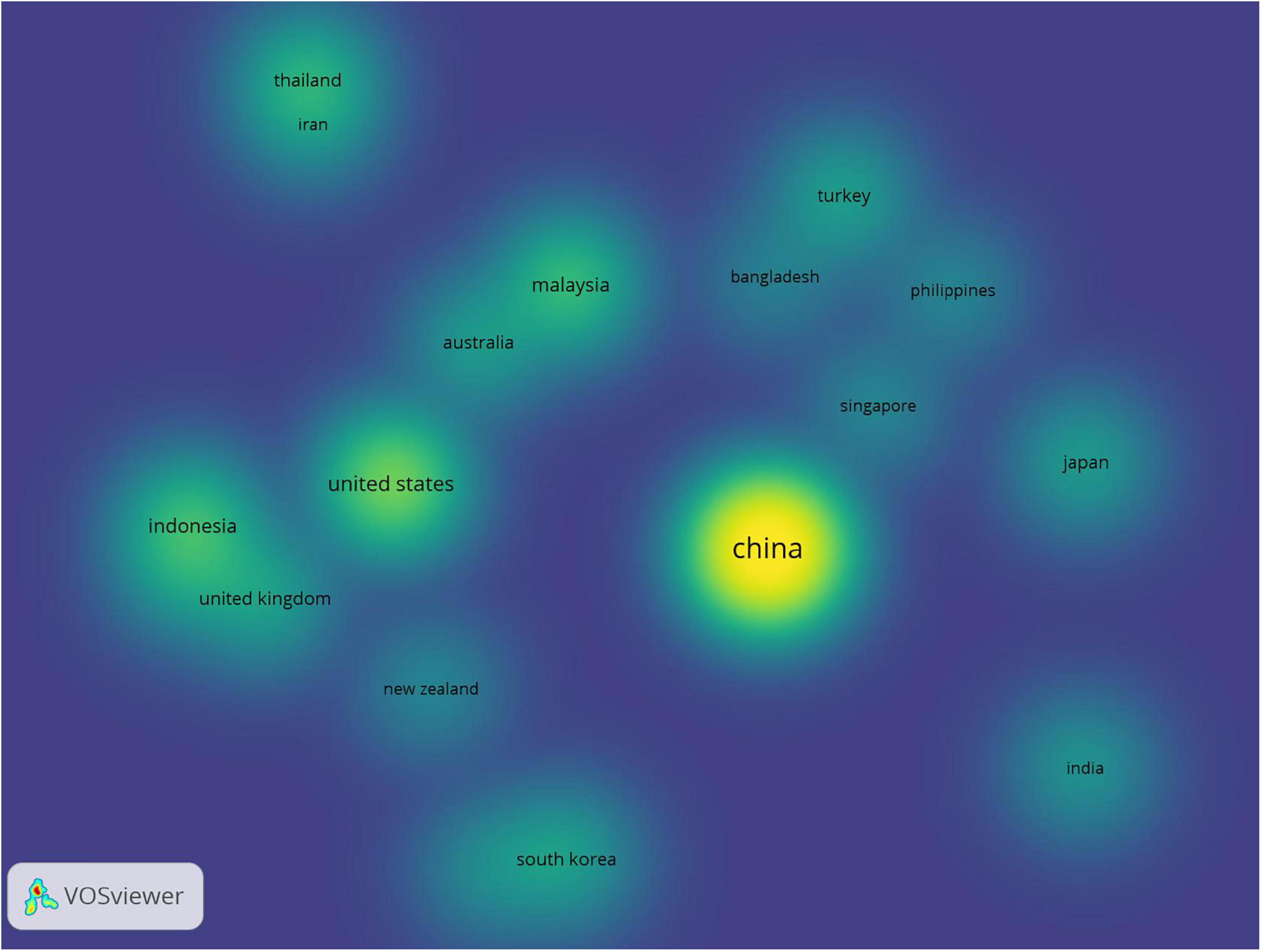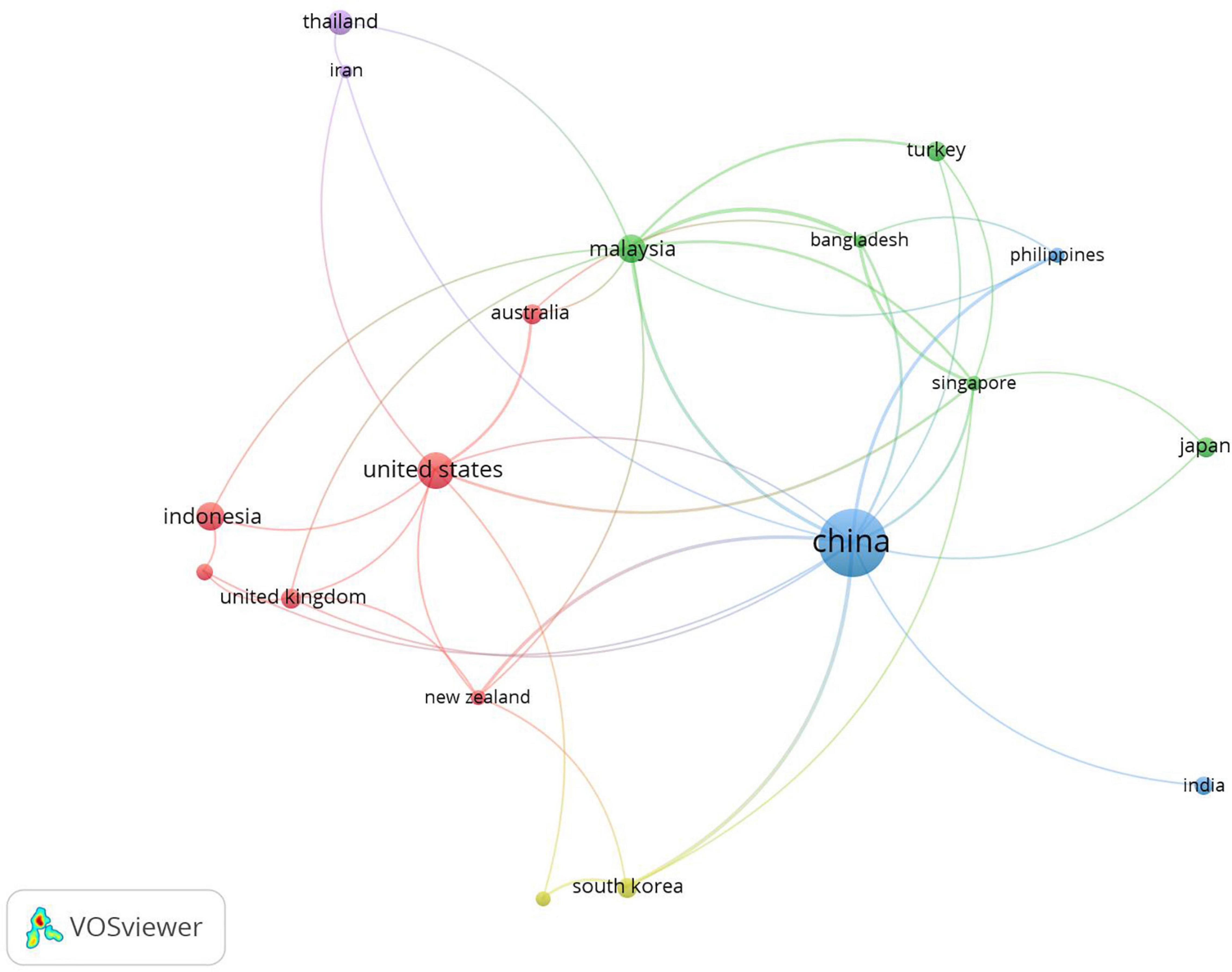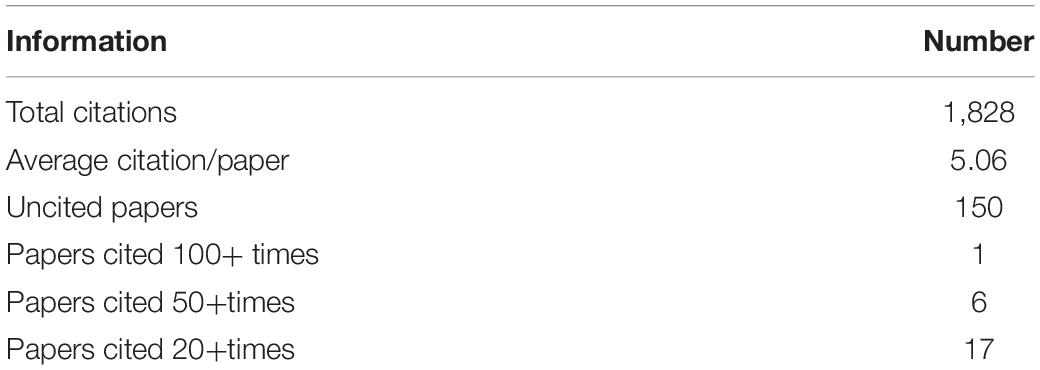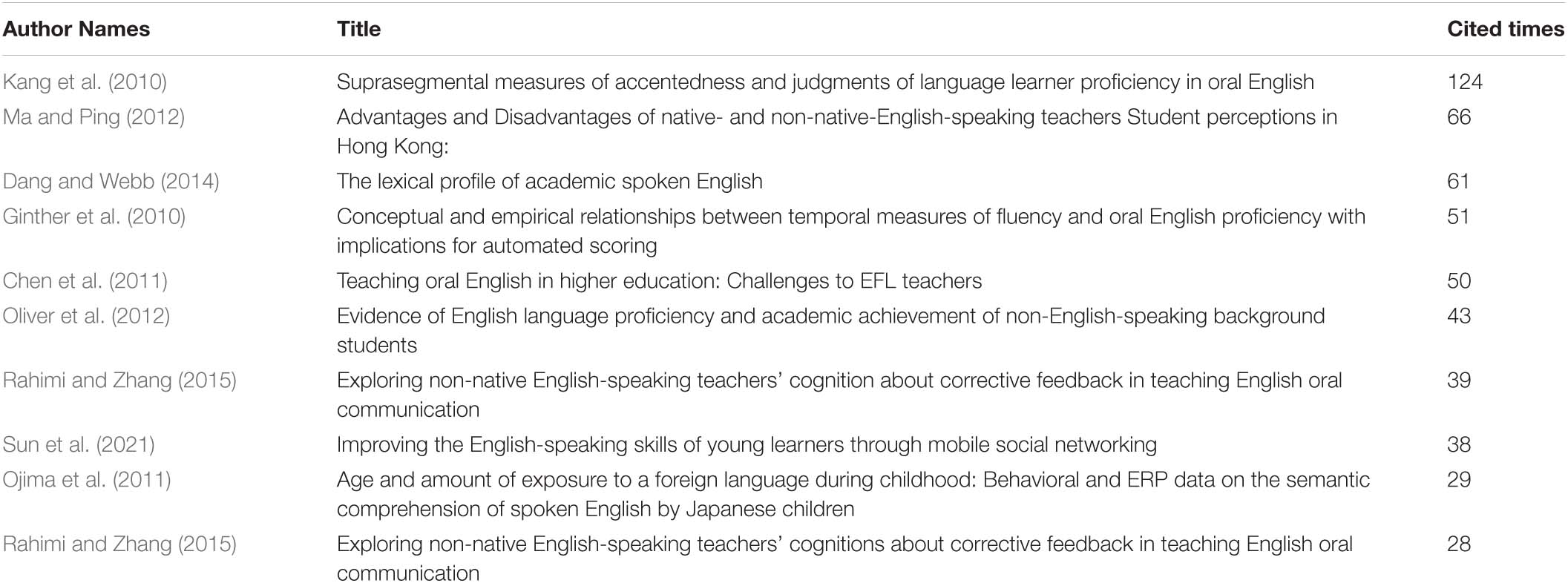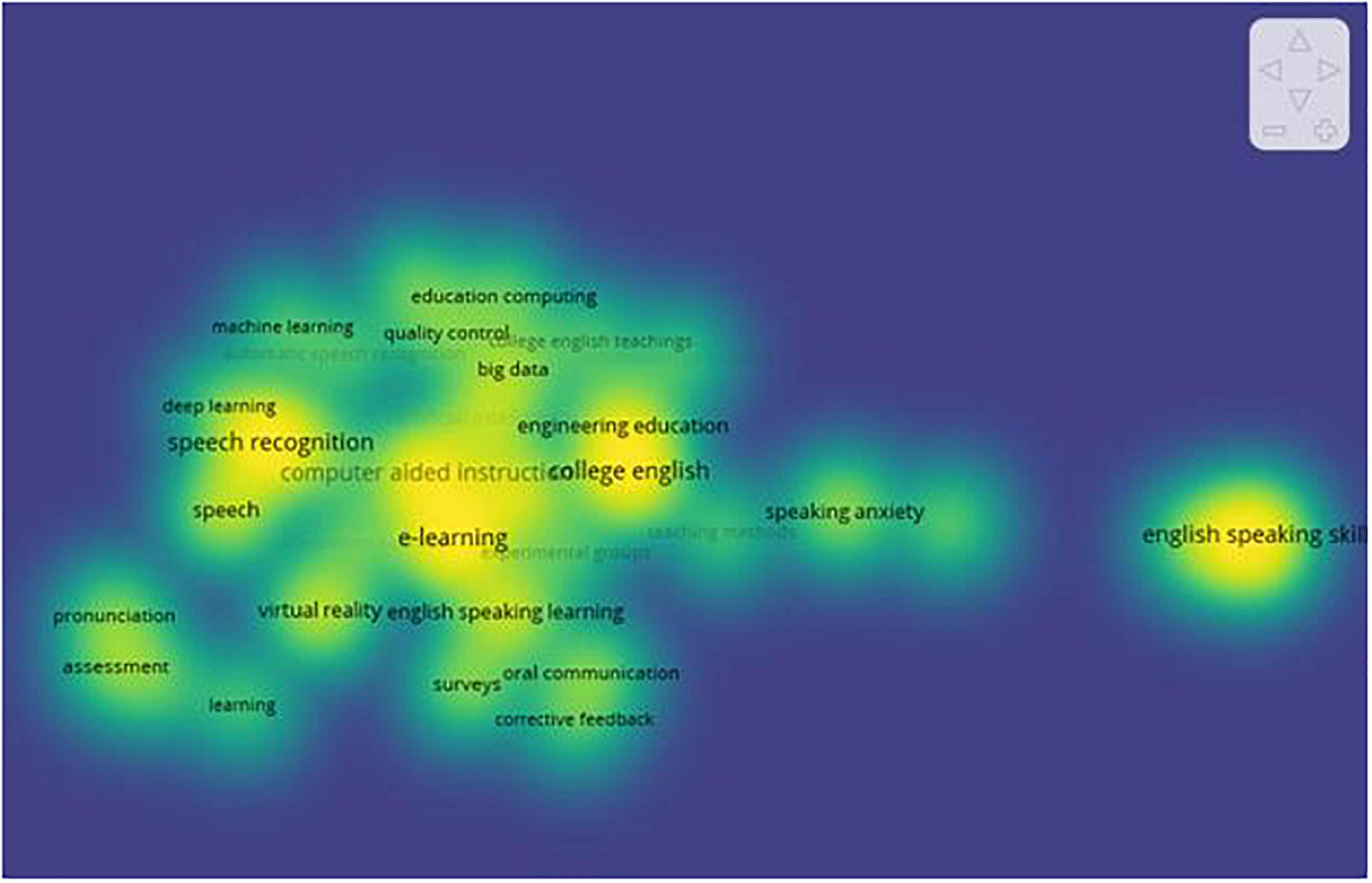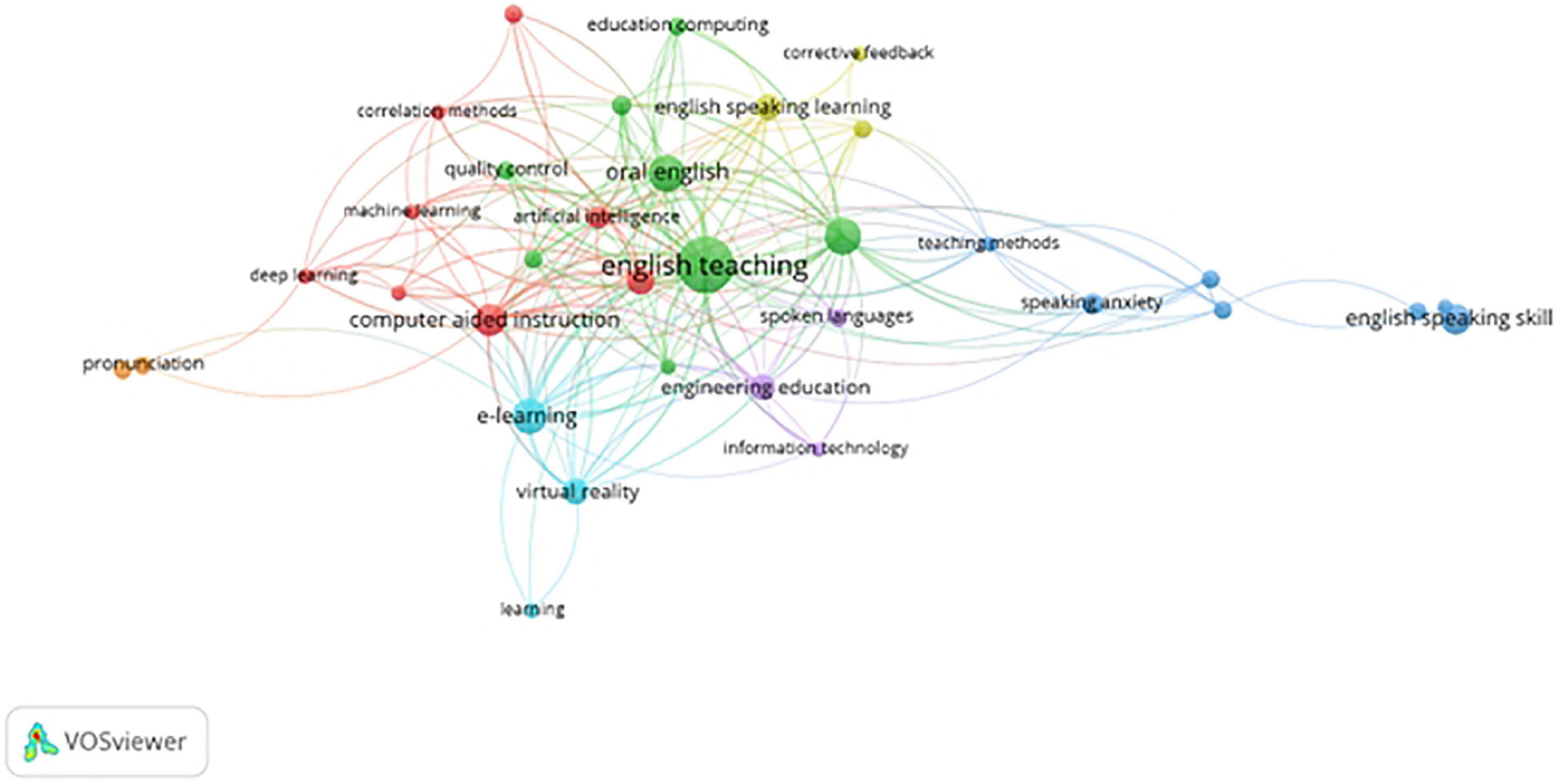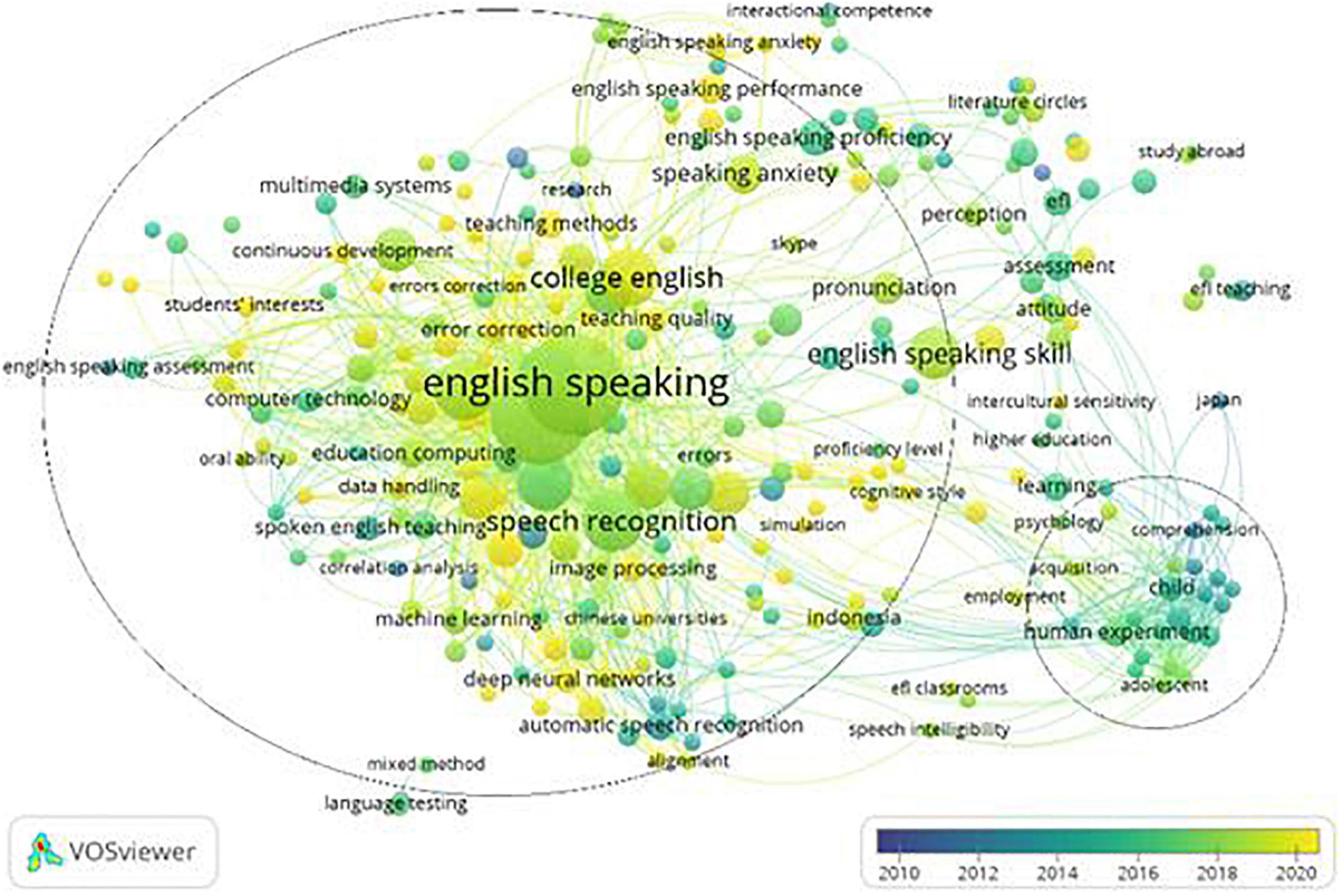- School of Educational Studies, Universiti Sains Malaysia, Penang, Malaysia
This study conducted a comprehensive historical review and bibliometric analysis of the literature on English-speaking (ES) education and mapped the current state of the field, trends, and emerging topics, as well as identified gaps where further research is needed. We retrieved 361 sample documents on ES teaching and learning in Scopus (2010–2021) under certain conditions and analyzed the extracted data using Excel and VOSviewer 1.6.17 from the perspectives of the number of yearly publications, countries, authors, citation numbers, and keywords. The findings show that the number of publications on ES education increased from 2010 to 2021, but there was a lack of sustained engagement with this topic by researchers. Countries with an ESL or EFL context focused more on the subject of ES, although studies from native ES countries were more influential. The research topics showed a multidimensional trend, covering communicative skills, language knowledge, assessment, teaching or learning methods, ICT-related applications, and cognitive factors, of which ICT-related applications (such as flipped classrooms, blended learning, and e-learning) and cognitive factors (such as motivation, anxiety, and affect) were the areas of focus. Students in higher institutions, rather than children, became the main research subject of ES education over the period studied.
Introduction
A considerable amount of time and money has been invested in English language education (ELE) around the world, especially in countries where English is a Foreign (EFL) or Second Language (ESL). For example, ELE in East Asian countries such as China, South Korea, and Japan has been identified as a necessary skill, which has motivated the development of various approaches and policies (Song, 2011; Hu and McKay, 2012). There have been at least three phases of English curriculum reforms by the Malaysian Ministry of Education directed toward improving students’ English proficiency and teachers’ professional development (TPD) (Rashid et al., 2017; Kummin et al., 2020).
Despite unremitting efforts in many countries, ELE is still facing the problem of low average English skills. For example, students’ English skills in Turkey are not as good as expected (Coskun, 2016; Özmen et al., 2016; Umunĉ and Raw, 2017). The survey by Wei and Su (2015) clearly showed that the subjects’ ES proficiency was generally low.
Many terms have been used to refer to the speaking aspects of the English language, e.g., “oral English,” “spoken English,” or “English speaking.” “English speaking” is the term used in this article. Speaking is different from writing, although both are productive skills, in that it is “transient, unplanned, context-dependent, oral/aural, and dynamic” (Hughes, 2017). English-speaking (ES) has been treated as an indivisible language skill for learners in the language education fields of TESOL, EFL, and ESL.
How to improve ES ability, including teaching and learning approaches, influencing factors, and other related issues, have always been a focus of researchers. Thus, in view of the profound changes in society, politics, economics, and technologies, this article aims to give an overview of the current situation and trends regarding ES studies based on Scopus from 2010 to 2021. Moreover, it seeks to provide useful information for further ES teaching and learning research through visualized data analysis using VOSviewer 1.6.17 and Micro Excel.
Thus, the research questions (RQs) of this article are as follows:
RQ1. What is the bibliometric information regarding publications about ES teaching and learning in Scopus (2010–2021), including the number of yearly publications, authors, citations, country contributions, and keywords?
RQ2. What is the status of ES teaching and learning?
RQ3. What are the most influential authors in the field of ES teaching and learning?
RQ4. What are the trends in ES teaching and learning?
RQ5. What are the gaps in ES teaching and learning from the bibliometric information?
Materials and Methods
Bibliometric analysis refers to the cross-science of quantitative analysis of all carriers of knowledge by means of mathematics and statistics (Broadus, 1987). The development of bibliometric software such as VOSviewer, Citespace, and Gephi, and the foundation of the big databases for academic documents such as Scopus, Web of Science, and Taylor and Francis make bibliometric analysis more feasible and practical (Donthu et al., 2021). Meanwhile, according to Rogers et al. (2020), the recommended minimum sample size for a bibliometric analysis is 200 entries.
Article Selection and Identification
Scopus was chosen as the database for this historical review and bibliometric analysis of ES education. This is because Scopus, as one of the world’s largest databases, covers a wide range of academic journals, conference proceedings, books, and other related publications with relatively high citation indexes and quality, much like the Web of Science (Pham et al., 2018; Baas et al., 2020). Scopus is user-friendly in the sense that information can be conveniently retrieved through string retrieval. This study replicated the methodologies used by Lázaro (2022) and Kaya and Erbay (2020). This article was conducted around RQs after the identification of some keywords as conditions for data mining.
Thus, 23,633 sample documents were first strictly extracted under the condition [TITLE-ABS-KEY (“English speaking” OR “English-speaking” OR “oral English” OR “spoken English”)] AND (“TESOL” OR “EFL” OR “ESL”). Then, the conditions of time span and document type were added for filtering from 2010 to 2021. Then, the articles, conference papers, reviews, book chapters, and books were chosen as the target document types. The detailed conditions can be seen in Table 1.
Finally, 1,893 documents were obtained. These were exported in the form of an Excel document with citation information, bibliographic information, abstract and keywords, funding details, and other information.
After strict data cleaning through thematic analysis of the abstracts by three researchers for more than three times, 361 sample documents remained, which were classified into four types of documents: journal articles (256; 70.91%), conference papers (79; 21.88%), book chapters (16; 4.43%), and reviews (10; 2.77%), covering more than 10 subject areas, such as social sciences, computer sciences, medicine, engineering, and arts and humanities.
Research Framework and Instruments
In the data selection step, sample documents were screened for information about authors, titles, years, citations, author keywords, index keywords, publishers, document types, countries, and author affiliations from Scopus under strict conditions. The sample documents were then uploaded to Excel and VOSviewer 1.6.17 during the data-processing step. Excel and VOSviewer 1.6.17 were used to perform the visualized bibliometric analysis of the number of publications per year, contributions of authors and countries, and keywords (Chen, 2016; Van Eck and Waltman, 2017). Finally, the current situation, developing trends, research gaps, and lessons we can learn about ES teaching were sorted. Thus, the research framework is divided into four main steps, as shown in Figure 1.
Results
Compared with studies on English writing and reading, studies on ES education are relatively very small in scale. Although only 361 sample documents conforming to the screening conditions were identified, it was still feasible to conduct a bibliometric analysis from the perspectives of the number of yearly publications, countries, authors, citations, and keywords.
Number of Publications by Year
According to the linear trend line in Figure 2, the overall trend of the ES education literature in Scopus was on the rise from 2010 to 2021. The number of publications in 2021 was six times more than that in 2010, indicating that ES education was gradually beginning to be taken seriously by researchers.
However, there were some tortuous changes. In 2010, only 10 studies were identified, but the percentage of the high citation index occupied 50%. From 2011 to 2018, the number of documents published in this area presented an up-and-down curve. The number of publications was slightly lower in 2012 than in 2021. This might be due to the decreased demand for ES education as a result of the economic downturn in many emerging economies such as China, South Korea, and Brazil (Reid, 2013). Yearly publications in this field increased from 2012 to 2013, but decreased again from 2013 to 2015, which was again in line with the global economic situation (Mau and Ulyukaev, 2015). In 2015, the number of publications was more or less the same as in 2010. The reasons for this might be that world trade reduced during the global crisis from 2014 to 2015 (Baber, 2015; Xu and Carey, 2015) or that no new research directions were explored during that time. After 2015, there was a continuous increase until 2017. After a subtle decrease in 2018, there was a significant accumulation in the number of publications from 2018 to 2021, showing a new growth trend. Especially in 2020 and 2021, when the COVID-19 pandemic brought disaster to the whole world, publications on ES education increased, reflecting the increasing requirement for ES communication during this time of global cooperation (Sun and Lan, 2021). The influence of the date on the extraction of the sample documents was not very great, as it was 12 December 2021.
Contributions and Collaborations by Country/Region
The 361 sample records extracted in Scopus from 2010 to 2021 were associated with around 40 countries, showing the global distribution of interest by country in ES education.
Figure 3 shows the top 20 countries/regions publishing articles in this field, and they were responsible for 344 ES education publications (2010–2021) (accounting for 95.29% of the total). The countries with big and bright circles were the ones with the large number of the publications. Apart from the 75 publications contributed by the United States, the United Kingdom, Australia, Canada, Spain, and New Zealand, the remaining 269 publications were published by 10 Asian countries, accounting for 74.52% of the total sample documents, which implied the huge demand for the improvement of the learners’ ES skills in those countries. Mainland China contributed 128 publications, accounting for 40.44% of the total, followed by the United States, with 38 documents, accounting for 10.53%.
Indonesia, Malaysia, and Thailand, countries in South-East Asia, occupied the third, fourth, and fifth positions, with 22, 22, and 18 publications, respectively. Thailand, Vietnam, the Philippines, and Bangladesh began to participate in country collaborations in recent years, in contrast to countries such as the United States, Australia, the United Kingdom, and Singapore where English is the native language or first language.
The citation network in Figure 4 shows only countries with more than five publications, which reflected the passive collaboration among the countries. As one of the native ES countries, home to many ELE approaches and English assessment tools such as TOFEL, the publications by the United States were cited 518 times (total link strength = 10). Meanwhile, the United Kingdom, home to IELTS, contributed 12 publications, which were cited 72 times (total link strength = 5). Malaysia, where ESL, contributed 22 publications, which were cited 90 times (total link strength = 17). Meanwhile, China, with an EFL context, ranked second with 128 publications, which were cited 395 times, and the total link strength achieved 24.
The total citation number of the 361 sample publications was 1,828. Table 2 provides detailed information on the 15 countries that published the most cited articles. The publication and the corresponding citation rate of the United States, Australia, New Zealand, and Singapore showed huge contrasts, respectively, 12.92, 19.45, 19.5, and 13.83. The high citation rate may to a certain extent represent a high reference value, although it may also be influenced by some highly cited papers (Schubert and Braun, 1986; Aksnes et al., 2012; Brika et al., 2021). Thus, it was concluded that the United States, Australia, New Zealand, and Singapore, where English was the official language, were the leading countries with high citation rates in the field of ES education studies. Similarly, native ES countries—the United Kingdom and Canada—showed relatively high citation rates of 5.83 and 6.14, respectively. Meanwhile, the citation rates of Asian countries such as China (4.73), Japan (6.35), South Korea (5.08), Vietnam (8.38), and Oman (6.75) indicated the progress and the relatively high reference value of publications on ES education studies in those countries. The non-ES European countries such as Spain received 4.57 in citation rates, which were much lower than those of the native ES countries.
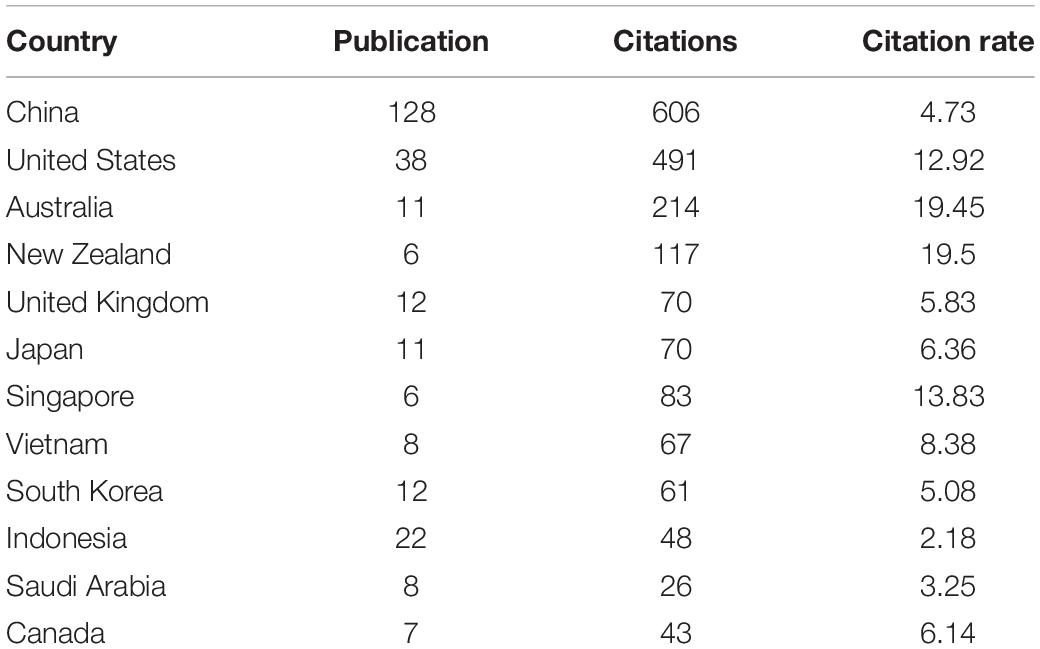
Table 2. Description of the 15 countries that published the most cited articles in the field of English-speaking (ES) education studies in Scopus (2010–2021).
Co-authorship among the countries is shown in Figure 5, which is a presentation of active collaborations. The co-authorship links among Malaysia, India, China, and the United States were linear. However, the collaboration in the map showed a tendency toward a partial focus. For instance, the United States was the main collaborating country for Indonesia, South Korea, Japan, Thailand, Canada, Australia, and Singapore. While China collaborated mainly with the United Kingdom, the Philippines, Turkey, Vietnam, and New Zealand. Thus, there was a need for an omnidirectional and multi-angle collaboration among the countries for ES teaching and learning research across the world for further studies.

Figure 5. The map of the co-authorship among the countries on English-speaking teaching and learning.
Author Contributions
Table 3 shows general information about the citations for the 361 sample documents in Scopus (2010–2021). As can be seen in Table 4, the topics of the top 10 most frequently cited articles were concerned with the assessment of ES proficiency and fluency, teachers’ influence, lexical acquisition, and the facilitation of mobile social networks. The total citation number was 1,828. On average, each document was cited 5.06 times. An experimental study by Kang et al. (2010) that proposed suprasegmental measurement for pronunciation assessment from the perspective of accent and equipment use was the most frequently cited article, which was cited 134 times. A qualitative study by Ma (2012) was cited 66 times, ranking second among the top 10 most frequently cited. It focused on ES teaching methods and investigated the advantages and disadvantages of native and non-native ES teachers in practice. The third most frequently cited article, which analyzed the academic lexical demands and academic word list coverage for ES communications by means of corpus, was cited 61 times (Dang and Webb, 2014). Obviously, most of the top 10 most frequently cited articles were published before 2016, except for the experimental studies by Sun and Lan (2021) on the application of e-learning to develop young learners’ ES competence, implying the emergence of new research topics after 2016 in ES teaching and learning studies.
The top 10 authors with more than three articles in order, were Ismail, K. (6), Abdullah, M. Y. (5), Hussin, S. (5), Liu, M. (5), Habil, H. (4), Chen, Z. (3), Hasan, M. K. (3), Hwang, G. J. (3), Rao, Z. (3), and Seraj, P. M. I. (4), and the co-authorship relationships can be seen in Figure 6. Seraj, P. M. I published four articles (one in 2020 and three in 2021) focusing on the topic of a flipped classroom. The other author with four publications was Liu M., studying the problem of Chinese EFL students’ anxiety, respectively, in 2013, 2018, 2018, and 2021. Rao Z. made three publications on the issues of native and non-native English teachers in China in 2010, 2016, and 2020.
Keyword Analysis
There were 1,049 keywords among the 361 sample documents, and only 49 keywords (2.88%) appeared more than five times after merging synonyms and deleting extraneous words. This indicates that the number of high-frequency keywords was relatively small, which reflects the relatively extensive content of ES research in the field of language education. Table 5 lists the top 10 keywords ordered by the frequency of occurrence apart from the retrieval words, among which the frequency of “ES skill” was the highest, accounting for 3.43%. The remaining keywords with a frequency greater than 10 were “speech recognition” (32), “College English” (26), “e-learning” (22), “computer-aided instruction” (19), “learning system” (14), “native-English speaking teachers” (13), anxiety (13), “oral communication” (12), “virtual reality” (11), and “artificial intelligence” (10). Obviously, the gap in frequency among keywords is not very large.
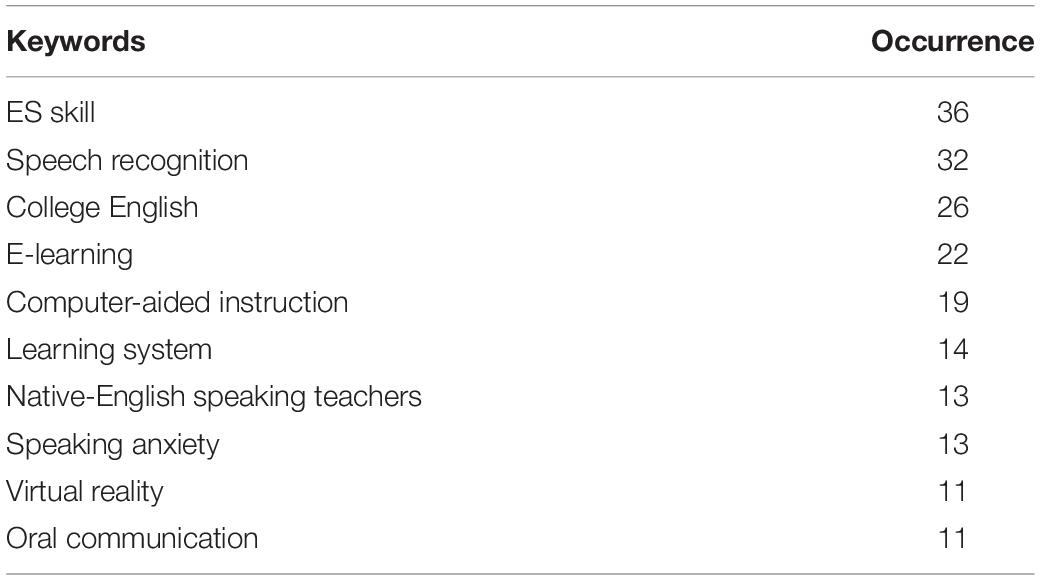
Table 5. The top 10 most frequently occurring keywords on English-speaking (ES) education in Scopus (2010–2021).
The bibliometric co-occurrence analysis of keywords provided a convenient way to assess the state of the research field and spot hot issues (Chen, 2016; Mutira et al., 2021; Sun and Lan, 2021). Meanwhile, importantly, keyword co-occurrence analysis can reflect the viewpoints of core academic articles and may be beneficial for researchers trying to keep up with research trends in a certain area (Li et al., 2016; Shoaib et al., 2021). Figure 6 shows the density of keywords that appeared more than 10 times; the brightness of the color represents the heat color of the keyword studied. The more studies, the brighter the color (Van Eck and Waltman, 2020). The colors of the keywords “English speaking skill,” “college English,” “computer-aided learning instruction,” and “speech recognition” were brighter than others. The other keywords, such as “speaking anxiety” and “e-learning,” were also brighter. To some extent, these brighter keywords reflected the research hotspots in the field of ES education from 2010 to 2021 in Scopus.
Keyword cluster analysis reflected the topics to some extent (Yang et al., 2017). After combining synonyms (e.g., oral English and spoken English; computer-aided learning and computer-aided instruction; and native and non-native ES teacher) and the deletion of non-sense words (e.g., human, priority journal, and education), the keywords except the retrieval terms “English speaking,” “oral English,” “English-speaking,” “spoken English,” “EFL,” “TESOL,” and “ESL” were categorized into seven clusters with three main topics, as seen in Figure 7. The keywords with red color dealt with the application of ICT in ES education, including items such as artificial intelligence, automatic speech recognition, computer-aided instruction, correlation methods, deep learning, information science, learning system, machine learning, quality control, correlation methods, corrective feedback, ES learning, oral communication, etc. Cluster 2 dealt with the cognitive factors influencing students’ ES skills or performance, such as attitude, EFL, English speaking performance, ES skill, the flipped classroom, motivation, speaking anxiety, and teaching methods, of which flipped classroom as a teaching method had the highest frequency of occurrence. Clusters 3 and 4 dealt with the application of ICT in college ES education, covering topics such as e-learning, engineering education, English speaking, learning, virtual reality, big data, college English, and educational computing. Cluster 7 dealt with the assessment of pronunciation or others.
Keyword Changes and the Enlightenment to Research Topics
Figure 8 reveals a change in the time distribution of topics. It was obvious that most of the light-colored nodes were close to the keyword “college English,” while there were only a few around the keywords “child,” “preschool,” and “adolescent” after 2016. This shows that college students had become the main subjects of ES education studies instead of young learners.
Meanwhile, studies with keywords related to the application of ICT, such as “big data,” “artificial intelligence,” “flipped classroom,” “speech recognition system,” and “virtual reality” in ES education, were emerging as a focus of research. Academic ES also began to attract researchers’ attention. Some researchers started to consider the development of twenty first-century skills during ES education. In addition, light-colored nodes of the keywords concerning teaching and learning modes (“continuous development,” “teaching method,” “EMI,” “error correction,” etc.), cognitive factors (“students’ interests,” “anxiety,” “motivation,” etc.), language skills (“ES performance,” “communicative skills,” “accuracy,” “fluency,” etc.), and language knowledge (“pronunciation,” “grammar,” etc.) remained the focus of research.
Limitations
The interpretation of the review should be very cautious due to some limitations. First, bibliometric analysis is a literature review method based on big data technology rather than synthesized thematic analysis. The data were collected and analyzed through the software. Thus, the accuracy of this analysis method is highly dependent on that of the software. The second limitation refers to the database. Though Scopus has covered the majority of the publications on ES teaching and learning worldwide, there are still some publications that were not included in the research.
Conclusion
This historical review and bibliometric analysis sought to better understand the current state of the research field, trends, and emerging research topics on ES education from 2010 to 2021. The results show that there was an increasing trend in the number of publications in this area from 2010 to 2021 in Scopus, indicating that ES education studies remained a necessary research topic, although the research population was not large. Countries with an ESL or EFL context, such as China, Japan, South Korea, Malaysia, Indonesia, and Saudi Arabia, paid more attention to the development of learners’ ES abilities and contributed more to ES education studies. However, the citation analysis revealed that native ES countries such as the United States, Australia, New Zealand, the United Kingdom, and Canada, were the major authorities or origins of ES education studies, which can also be seen by author contributions. Country collaboration analysis showed that the United States, China, India, and Malaysia acted as hubs of contact, establishing overall relationships within the collaboration network. In addition, the analysis of author distribution and collaboration revealed that there were constantly new researchers entering this field, but the lack of authors focusing on ES education over the long term and sustained research was still a problem. Further exploration of keywords revealed that the hot research issues encompass communicative skills, language knowledge, assessment, teaching or learning methods, ICT-related applications, and cognitive factors. Rather than focusing on ES education for young and adolescent learners, researchers showed a preference for investigating ES education for college students, catering to the increasing requirements of oral international communication. Meanwhile, topics on ICT application, autonomous learning, academic ES ability, and twenty first-century learning skills are gradually becoming hot areas for the improvement of ES teaching and learning worldwide.
Author Contributions
JW was the research designer and executor of this study, participated in and completed the data analysis, and wrote the first draft of the manuscript. RA and L-ML gave suggestions when necessary. All authors contributed to the article and approved the submitted version.
Conflict of Interest
The authors declare that the research was conducted in the absence of any commercial or financial relationships that could be construed as a potential conflict of interest.
Publisher’s Note
All claims expressed in this article are solely those of the authors and do not necessarily represent those of their affiliated organizations, or those of the publisher, the editors and the reviewers. Any product that may be evaluated in this article, or claim that may be made by its manufacturer, is not guaranteed or endorsed by the publisher.
Acknowledgments
JW would like to express their gratitude to RA and L-ML who participated in this project.
References
Aksnes, D. W., Schneider, J. W., and Gunnarsson, M. (2012). Ranking national research systems by citation indicators: a comparative analysis using whole and fractionalized counting methods. J. Informetr. 6, 36–43. doi: 10.1016/j.joi.2011.08.002
Baas, J., Schotten, M., Plume, A., Côté, G., and Karimi, R. (2020). Scopus as a curated, high-quality bibliometric data source for academic research in quantitative science studies. Quant. Sci. Stud. 1, 377–386. doi: 10.1162/qss_a_00019
Baber, G. (2015). “The European Union’s legislative response to the financial crisis: a perspective taken from 2015,” in Global Financial Crisis: Causes, Consequences and Impact on Economic Growth, 89–158.
Brika, S. K. M., Algamdi, A., Chergui, K., Musa, A. A., and Zouaghi, R. (2021). Quality of higher education: a bibliometric review study. Front. Educ. 6:666087. doi: 10.3389/feduc.2021.666087
Broadus, R. N. (1987). Toward a definition of “bibliometrics”. Scientometrics 12, 373–379. doi: 10.1007/BF02016680
Chen, M.-L. (2016). Development of corpus-based studies in second/foreign language acquisition and pedagogy from 1990 to 2015: a bibliometric analysis. Engl. Teach. Learn. 40, 1–38. doi: 10.6330/ETL.2016.40.4.01
Chen, Z., Goh, C., and Chuen, M. (2011). Teaching oral English in higher education: challenges to EFL teachers. Teach. High. Educ. 16, 333–343. doi: 10.1080/09500782.2011.609281
Coskun, A. (2016). Causes of the ‘i can understand english, but i can’t speak’ syndrome in turkey. J. Engl. Lang. Teach. 6, 1–12. doi: 10.26634/jelt.6.3.8174
Dang, T. N. Y., and Webb, S. (2014). The lexical profile of academic spoken English. Eng. Specif. Purp. 33, 66–76. doi: 10.1016/j.esp.2013.08.001
Donthu, N., Kumar, S., Mukherjee, D., Pandey, N., and Lim, W. M. (2021). How to conduct a bibliometric analysis: an overview and guidelines. J. Bus. Res. 133, 285–296. doi: 10.1016/j.jbusres.2021.04.070
Ginther, A., Dimova, S., and Yang, R. (2010). Conceptual and empirical relationships between temporal measures of fluency and oral English proficiency with implications for automated scoring. Lang. Test. 27, 379–399. doi: 10.1177/0265532210364407
Hu, G., and McKay, S. L. (2012). English language education in East Asia: some recent developments. J. Multiling. Multicult. Dev. 33, 345–362. doi: 10.1080/01434632.2012.661434
Kang, O., Rubin, D., and Pickering, L. (2010). Suprasegmental measures of accentedness and judgments of language learner proficiency in oral English. Mod. Lang. J. 94, 554–566.
Kaya, M., and Erbay, E. (2020). Global trends of the research on COVID-19: a bibliometric analysis via VOSviewer. J. Ankara Health Sci. 9, 201–216.
Kummin, S., Surat, S., Amir, R., Maslawati, M., and Md Melor, Y. (2020). The effects of meta-discussion strategies toward low english proficiency students in oral english performance. Asia Pacific J. Educ. Educ. 35, 75–91. doi: 10.21315/apjee2020.35.1.5
Lázaro, I. G. (2022). Integration and management of technologies through practicum experiences: a review in preservice teacher education (2010–2020). Contemp. Educ. Technol. 14:e352.
Li, H., An, H., Wang, Y., and Huang, J. (2016). Evolutionary features of academic articles co-keyword network and keywords co-occurrence network: based on two-mode affiliation network. Phys. A 450, 657–669. doi: 10.1016/j.physa.2016.01.017
Ma, F., and Ping, L. (2012). Advantages and disadvantages of native- and nonnative-English-speaking teachers: student perceptions in Hong Kong. TESOL Q. 46, 280–305. doi: 10.1002/tesq.21
Mau, V., and Ulyukaev, A. (2015). Global crisis and challenges for Russian economic development. Russian J. Econ. 1, 4–29. doi: 10.1016/j.ruje.2015.05.003
Mutira, P., Meutia, Y. H., and Bastian, E. (2021). A bibliometrics analysis of management control system. Rev. Int. Geogr. Educ. Online 11, 2634–2649. doi: 10.48047/rigeo.11.05.160
Ojima, S. Matsuba-Kurita, H., Nakamura, N., Hoshino, T., and Hagiwara, H. (2011). Age and amount of exposure to a foreign language during childhood: behavioral and ERP data on the semantic comprehension of spoken English by Japanese children. Neurosci. Res. 70, 197–205. doi: 10.1016/j.neures.2011.01.018
Oliver, R., Vanderford, S., and Grote, E. (2012). Evidence of English language proficiency and academic achievement of non-English-speaking background students. High. Educ. Res. Dev. 31, 541–555. doi: 10.1080/07294360.2011.653958
Özmen, K. S., Cephe, P. T., and Kınık, B. (2016). Trends in doctoral research on English language teaching in Turkey. Kuram Uygulamada Egitim Bilimleri 16, 1737–1759. doi: 10.12738/estp.2016.5.0069
Pham, X. L., Nguyen, T. H., and Chen, G. D. (2018). Research through the app store: understanding participant behavior on a mobile English learning app. J. Educ. Comput. Res. 56, 1076–1098. doi: 10.1177/0735633117727599
Rahimi, M., and Zhang, L. J. (2015). Exploring non-native English-speaking teachers’ cognitions about corrective feedback in teaching English oral communication. System 55, 111–122. doi: 10.1016/j.system.2015.09.006
Rashid, R. A. B., Abdul Rahman, S. B., and Yunus, K. (2017). Reforms in the policy of English language teaching in Malaysia. Policy Futures Educ. 15, 100–112. doi: 10.1177/1478210316679069
Reid, C. D. (2013). World economic outlook April 2013: hopes, realities, risks. Ref. Rev. 28, 23–24. doi: 10.1108/RR-02-2014-0042
Rogers, G., Szomszor, M., and Adams, J. (2020). Sample size in bibliometric analysis. Scientometrics 125, 777–794. doi: 10.1007/s11192-020-03647-7
Schubert, A., and Braun, T. (1986). Relative indicators and relational charts for comparative assessment of publication output and citation impact. Scientometrics 9, 281–291. doi: 10.1007/BF02017249
Shoaib, M., Ali, N., Anwar, B., Rasool, S., Mustafa, R. E., and Shi, Z. (2021). Research visualization on teaching, language, learning of English and higher education institutions from 2011 to 2020: bibliometric evidence. Libr. Philos. Pract. 2021, 1–27.
Song, J. J. (2011). English as an official language in South Korea: global English or social malady? Lang. Prob. Lang. Plan. 35, 35–55. doi: 10.1075/lplp.35.1.03son
Sun, X., Xie, B., and Zhu, R. (2021). “A review of oral english teaching methodologies in chinese colleges,” in Proceedings of the 3rd International Conference on Literature, Art and Human Development (ICLAHD 2021), (Amsterdam: Atlantis Press), 368–372. doi: 10.2991/assehr.k.211120.069
Sun, Y., and Lan, G. (2021). Research trends in ‘trans-’ studies on writing: a bibliometric analysis. System 103, 1–12. doi: 10.1016/j.system.2021.102640
Umunĉ, H., and Raw, L. (2017). Reassessing english studies in turkey. Ariel 48, 137–145. doi: 10.1353/ari.2017.0005
Van Eck, N. J., and Waltman, L. (2017). Citation-based clustering of publications using CitNetExplorer and VOSviewer. Scientometrics 111, 1053–1070. doi: 10.1007/s11192-017-2300-7
Van Eck, N. J., and Waltman, L. (2020). VOSviewer Manual Version 1.6.16. Leiden: Univeristeit Leiden.
Wei, R., and Su, J. (2015). Surveying the English language across China. World Engl. 34, 175–189. doi: 10.1002/jid.3120
Xu, J., and Carey, R. (2015). Post-2015 Global governance of official development finance: harnessing the renaissance of public entrepreneurship. J. Int. Dev. 27, 856–880.
Keywords: English-speaking skills, bibliometric analysis, research trends, enlightenment, research state
Citation: Wang J, Abdullah R and Leong L-M (2022) Studies of Teaching and Learning English-Speaking Skills: A Review and Bibliometric Analysis. Front. Educ. 7:880990. doi: 10.3389/feduc.2022.880990
Received: 22 February 2022; Accepted: 01 June 2022;
Published: 06 July 2022.
Edited by:
Peter Kokol, University of Maribor, SloveniaReviewed by:
Jamal Kaid Mohammed Ali, University of Bisha, Saudi ArabiaWen Xu, East China Normal University, China
Copyright © 2022 Wang, Abdullah and Leong. This is an open-access article distributed under the terms of the Creative Commons Attribution License (CC BY). The use, distribution or reproduction in other forums is permitted, provided the original author(s) and the copyright owner(s) are credited and that the original publication in this journal is cited, in accordance with accepted academic practice. No use, distribution or reproduction is permitted which does not comply with these terms.
*Correspondence: Rohaya Abdullah, cm9oYXlhbWZkYUB1c20ubXk=
 Juan Wang
Juan Wang Rohaya Abdullah
Rohaya Abdullah Lai-Mei Leong
Lai-Mei Leong